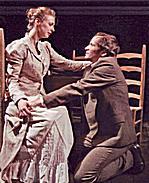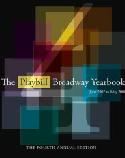SITE GUIDE
SEARCH
REVIEWS
REVIEW ARCHIVES
ADVERTISING AT CURTAINUP
FEATURES
NEWS
Etcetera and
Short Term Listings
LISTINGS
Broadway
Off-Broadway
NYC Restaurants
BOOKS and CDs
OTHER PLACES
Berkshires
London
California
New Jersey
Philadelphia
Elsewhere
QUOTES
TKTS
PLAYWRIGHTS' ALBUMS
LETTERS TO EDITOR
FILM
LINKS
MISCELLANEOUS
Free Updates
Masthead
A CurtainUp Review
The Widowing Of Mrs. Holroyd
By Elyse Sommer
|
I ought never to have looked at you.— Mrs. Holroyd to the husband she married in haste but never loved enough.
|

Julia Coffey and Nick Cordileone in The Widowing of Mrs Holroyd
(Photo: Richard Termine) |
While Lawrence achieved fame in his lifetime, he never saw any of the eight plays he wrote produced. The productions of The Daughter-In-Law by the Young Vic in London and The Mint in New York were highly overdue treats. The play was one of the Mint's big hits that was extended from a limited to an open run. Small wonder that Jonathan Bank, the company's artistic director, opted to stage another Lawrence play, and that interest by the Mint's many fans has extended the run of The Widowing of Mrs. Holroyd even before the official opening.
Like The Daughter-In-Law, and much of Lawrence's other work, The Widowing of Mrs Holroyd is set in a stultifyingly drab, misery-filled mining town, a locale he knew first-hand as a youngster. Like The Daughter-In-Law, this production recreates the atmosphere of this suffocating life style and draws on Lawrence's own miner father and schoolteacher mother's marriage that, as Mrs. Gasgoyne of The Daughter-In-Law puts it, "is like a mousetrap for either man or woman—you soon come to the end of the cheese." The two plays' similarities extend to the tensions resulting from the ever dangerous but underpaid work in the mines and an inheritance that exacerbates the marital problems — in this case from the wife's uncle whose harsh guardianship led to her marrying the first man who came along.
The Widowing of Mrs. Holroyd actually began as Lawrence's first published short story, "Odour of Chrysanthemums." While the play has more interpersonal complications than that story, it nevertheless relies less on plot complications for its emotional involvement than the rituals of life in this claustrophobic world.
As for suspense, the title points to its absence. Since Mrs. Holroyd's husband is listed as a character it's clear that the grim reaper is going to get him at some point. That said, the play can't really be faulted for total predictability. Despite the "widowing" the title foreshadows there is a degree of suspense inherent in not knowing how or when it will come about and how, in this morally righteous Christian world, it will affect the Holroyd family —and, most importantly, Mrs. Holroyd's relationship with the gentle, young electrician who's fallen in love with her.
For anyone who saw the Mint's earlier Lawrence play comparisons between it and The Widowing of Mrs. Holroyd are inevitable. The scene when Luther, the husband in The Daughter-in-Law answers Minnie's plaintive "Did you never care for me?" with "You never wanted me-- you thought me dirt" is echoed by Charles Holroyd's furious retort to his wife's threat to leave him with "Go then, for you;'ve always been too big for your shows, in my ouse. [sic]" But, though these paralells would indicate these plays to be of a piece, The Daughter-in-Law has more of the hallmarks of Lawrence's later, more mature fiction and conflicts and confrontations between the characters is more compelling and complex.
I'm not sure if the just opened production might be on an equal footing with its predecessor if director Stuart Howard had stepped up the pace. Probably. On the other hand he's steered his designers to give us an authentic picture of a miner's home circa 1914. Marion Williams's set has provided the Holroyd home a scrim wall that gives us a glimpse of the village beyond the front door. Martha Halley's costumes add to the visual authenticity, and Jeff Nellis's lighting to the dour atmosphere.
Mr. Howard also draws fine performances from the actors, none of whom are well known, though all perform well and ably handle the challenging dialect of the miing region. Julia Coffey embodies the frustrations and yearnings of the title character. Her Lizzie is a virtual cauldron of anger and discontent as she goes about folding and ironing the family laundry, with just enough of the lively woman inside this burnt out drudge surfacing when she's with her youngsters (endearingly portrayed by Dalton Harradd and Emma Kantor) and the young electrician (Nick Conrdilone) who has fallen in love with her.
And so, while I found The Widowing of Mrs. Holroyd too slow and understated to be as satisfying as The Daughter-in-Law, it's an interesting companion piece and affords a rare opportunity to see this little known play performed live. It's been televised several times, primarily as an acting tour-de-force for Zoe Wannamaker and Geraldine Fitzgerald, but you have to see Julia Coffey and her stage-mother-in-law, Randy Danson, to experience the full power of the final scene in which these women achieve a closeness that neither ever had with her husband.
As usual, this production fulfills the Mint's mission to add an educational and enriching component to their effort to call attention to neglected plays. Besides coaching the actors, dramaturge and dialect expert Amy Stoller has added some interesting notes on the speech of these characters to the program notes. They include a whole page of excerpted bits of dialogue with explanatory commentary.
The Mint also has a publishing arm. One of their most intriguing and timely anthologies Harley Granville Barker Reclaimed, edited by Jonathan Bank, includes the text of The Voysey Inheritance-- another Mint hit and an eerily prescient precursor of the Madoff Ponzi scheme scandal.
LINKS
Curtainup's review of The Daughter-In-Law at the Mint and in London.
|
The Widowing Of Mrs. Holroyd By D.H. Lawrence Directed by Stuart Howard Cast: Eric Martin Brown (Holroyd), Allyn Burrows (Manager), Julia Coffey (Mrs. Holroyd), Nick Cordileone (Blackmore), Randy Danson (Grandmother), Dalton Harrod (Jack Holeroyd), Emma Kantor (Minnie Holroyd), Arthur Lazalude (Minor), Sheila Stasack (Laura), James Warke (Rigley), Pilar Witherspoon (Clara) Set design by Marion Williams Costume design by Martha Hally Lighting design by Jeff Nellis Sound design by Jane Shaw Fight Choreography: Michael G. Chin Dialects and Dramaturgy: Amy Stoller Stage Manager: Allison Deutsch Running Time: 1 hour and 55 minutes, includes one intermission after Act II Mint Theater Company Third Floor of 311 West 43rd Street. www.minttheater.orgl 212/315-0231. From 2/04/09; opening 3/01/09; closing 3/29/09. Tuesday through Thursday at 7PM, Friday at 8PM, Saturday at 2 PM and 8 PM and Sunday at 2 PM. Tickets will be $55. $25 for anyone under 25 years of age, subject to availability. Reviewed by Elyse Sommer on Feb. 27th |
|
REVIEW FEEDBACK Highlight one of the responses below and click "copy" or"CTRL+C"
Paste the highlighted text into the subject line (CTRL+ V): Feel free to add detailed comments in the body of the email. . .also the names and emails of any friends to whom you'd like us to forward a copy of this review. You can also contact us at Curtainup at Facebook or Curtainup at Twitter |
Try onlineseats.com for great seats to
Wicked
Jersey Boys
The Little Mermaid
Lion King
Shrek The Musical

South Pacific

In the Heights

Playbill 2007-08 Yearbook

Leonard Maltin's 2008 Movie Guide


Wicked
Jersey Boys
The Little Mermaid
Lion King
Shrek The Musical

South Pacific

In the Heights

Playbill 2007-08 Yearbook

Leonard Maltin's 2008 Movie Guide


